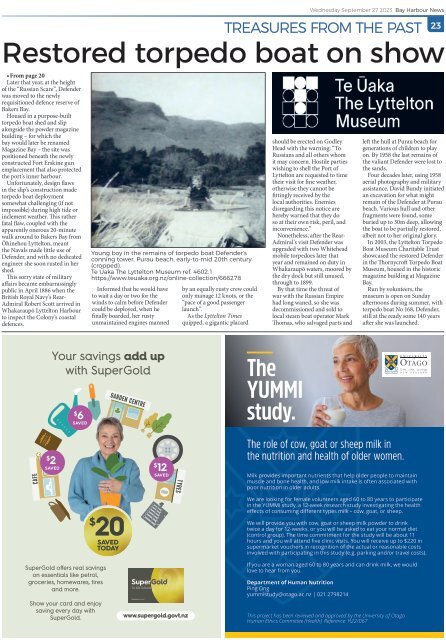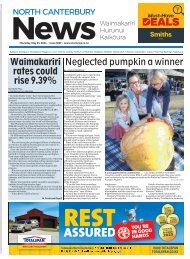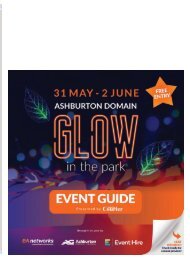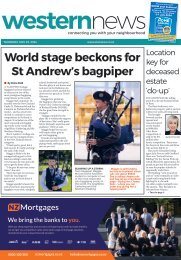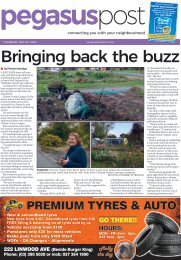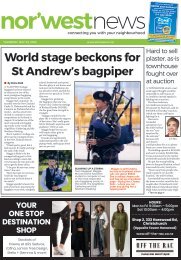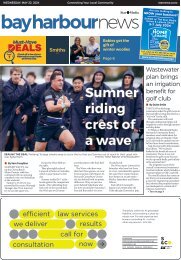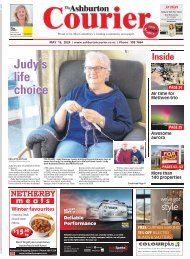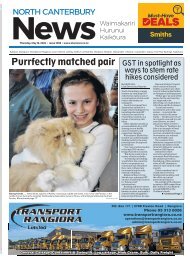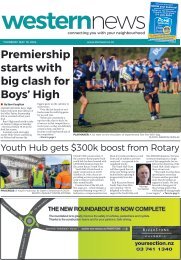Bay Harbour: September 27, 2023
Create successful ePaper yourself
Turn your PDF publications into a flip-book with our unique Google optimized e-Paper software.
Wednesday <strong>September</strong> <strong>27</strong> <strong>2023</strong> <strong>Bay</strong> <strong>Harbour</strong> News<br />
TREASURES FROM THE PAST 23<br />
Restored torpedo boat on show<br />
• From page 20<br />
Later that year, at the height<br />
of the “Russian Scare”, Defender<br />
was moved to the newly<br />
requisitioned defence reserve of<br />
Bakers <strong>Bay</strong>.<br />
Housed in a purpose-built<br />
torpedo boat shed and slip<br />
alongside the powder magazine<br />
building – for which the<br />
bay would later be renamed<br />
Magazine <strong>Bay</strong> – the site was<br />
positioned beneath the newly<br />
constructed Fort Erskine gun<br />
emplacement that also protected<br />
the port’s inner harbour.<br />
Unfortunately, design flaws<br />
in the slip’s construction made<br />
torpedo boat deployment<br />
somewhat challenging (if not<br />
impossible) during high tide or<br />
inclement weather. This rather<br />
fatal flaw, coupled with the<br />
apparently onerous 20-minute<br />
walk around to Bakers <strong>Bay</strong> from<br />
Ōhinehou Lyttelton, meant<br />
the Navals made little use of<br />
Defender, and with no dedicated<br />
engineer she soon rusted in her<br />
shed.<br />
This sorry state of military<br />
affairs became embarrassingly<br />
public in April 1886 when the<br />
British Royal Navy’s Rear-<br />
Admiral Robert Scott arrived in<br />
Whakaraupō Lyttelton <strong>Harbour</strong><br />
to inspect the Colony’s coastal<br />
defences.<br />
Young boy in the remains of torpedo boat Defender’s<br />
conning tower, Purau beach, early-to-mid 20th century<br />
(cropped).<br />
Te Ūaka The Lyttelton Museum ref. 4602.1<br />
https://www.teuaka.org.nz/online-collection/666<strong>27</strong>8<br />
Informed that he would have<br />
to wait a day or two for the<br />
winds to calm before Defender<br />
could be deployed, when he<br />
finally boarded, her rusty<br />
unmaintained engines manned<br />
by an equally rusty crew could<br />
only manage 12 knots, or the<br />
“pace of a good passenger<br />
launch”.<br />
As the Lyttelton Times<br />
quipped, a gigantic placard<br />
should be erected on Godley<br />
Head with the warning: “To<br />
Russians and all others whom<br />
it may concern. Hostile parties<br />
wishing to shell the Port of<br />
Lyttelton are requested to time<br />
their visit for fine weather,<br />
otherwise they cannot be<br />
fittingly received by the<br />
local authorities. Enemies<br />
disregarding this notice are<br />
hereby warned that they do<br />
so at their own risk, peril, and<br />
inconvenience.”<br />
Nonetheless, after the Rear-<br />
Admiral’s visit Defender was<br />
upgraded with two Whitehead<br />
mobile torpedoes later that<br />
year and remained on duty in<br />
Whakaraupō waters, moored by<br />
the dry dock but still unused,<br />
through to 1899.<br />
By that time the threat of<br />
war with the Russian Empire<br />
had long waned, so she was<br />
decommissioned and sold to<br />
local steam boat operator Mark<br />
Thomas, who salvaged parts and<br />
left the hull at Purau beach for<br />
generations of children to play<br />
on. By 1958 the last remains of<br />
the valiant Defender were lost to<br />
the sands.<br />
Four decades later, using 1958<br />
aerial photography and military<br />
assistance, David Bundy initiated<br />
an excavation for what might<br />
remain of the Defender at Purau<br />
beach. Various hull and other<br />
fragments were found, some<br />
buried up to 30m deep, allowing<br />
the boat to be partially restored,<br />
albeit not to her original glory.<br />
In 2003, the Lyttelton Torpedo<br />
Boat Museum Charitable Trust<br />
showcased the restored Defender<br />
in the Thornycroft Torpedo Boat<br />
Museum, housed in the historic<br />
magazine building at Magazine<br />
<strong>Bay</strong>.<br />
Run by volunteers, the<br />
museum is open on Sunday<br />
afternoons during summer, with<br />
torpedo boat No 168, Defender,<br />
still at the ready some 140 years<br />
after she was launched.<br />
Your savings add up<br />
with SuperGold<br />
$<br />
6<br />
SAVED<br />
$<br />
2 $<br />
12<br />
SAVED<br />
$<br />
20<br />
SAVED<br />
TODAY<br />
SAVED<br />
The<br />
YUMMI<br />
study.<br />
The role of cow, goat or sheep milk in<br />
the nutrition and health of older women.<br />
Milk provides important nutrients that help older people to maintain<br />
muscle and bone health, and low milk intake is often associated with<br />
poor nutrition in older adults.<br />
We are looking for female volunteers aged 60 to 80 years to participate<br />
in the YUMMI study, a 12-week research study investigating the health<br />
effects of consuming different types milk – cow, goat, or sheep.<br />
We will provide you with cow, goat or sheep milk powder to drink<br />
twice a day for 12-weeks, or you will be asked to eat your normal diet<br />
(control group). The time commitment for the study will be about 11<br />
hours and you will attend five clinic visits. You will receive up to $220 in<br />
supermarket vouchers in recognition of the actual or reasonable costs<br />
involved with participating in this study (e.g. parking and/or travel costs).<br />
SuperGold offers real savings<br />
on essentials like petrol,<br />
groceries, homewares, tires<br />
and more.<br />
Show your card and enjoy<br />
saving every day with<br />
SuperGold.<br />
www.supergold.govt.nz<br />
If you are a woman aged 60 to 80 years and can drink milk, we would<br />
love to hear from you.<br />
Department of Human Nutrition<br />
Ping Ong<br />
yummistudy@otago.ac.nz | 021 <strong>27</strong>98214<br />
This project has been reviewed and approved by the University of Otago<br />
Human Ethics Committee (Health). Reference: H22/067


